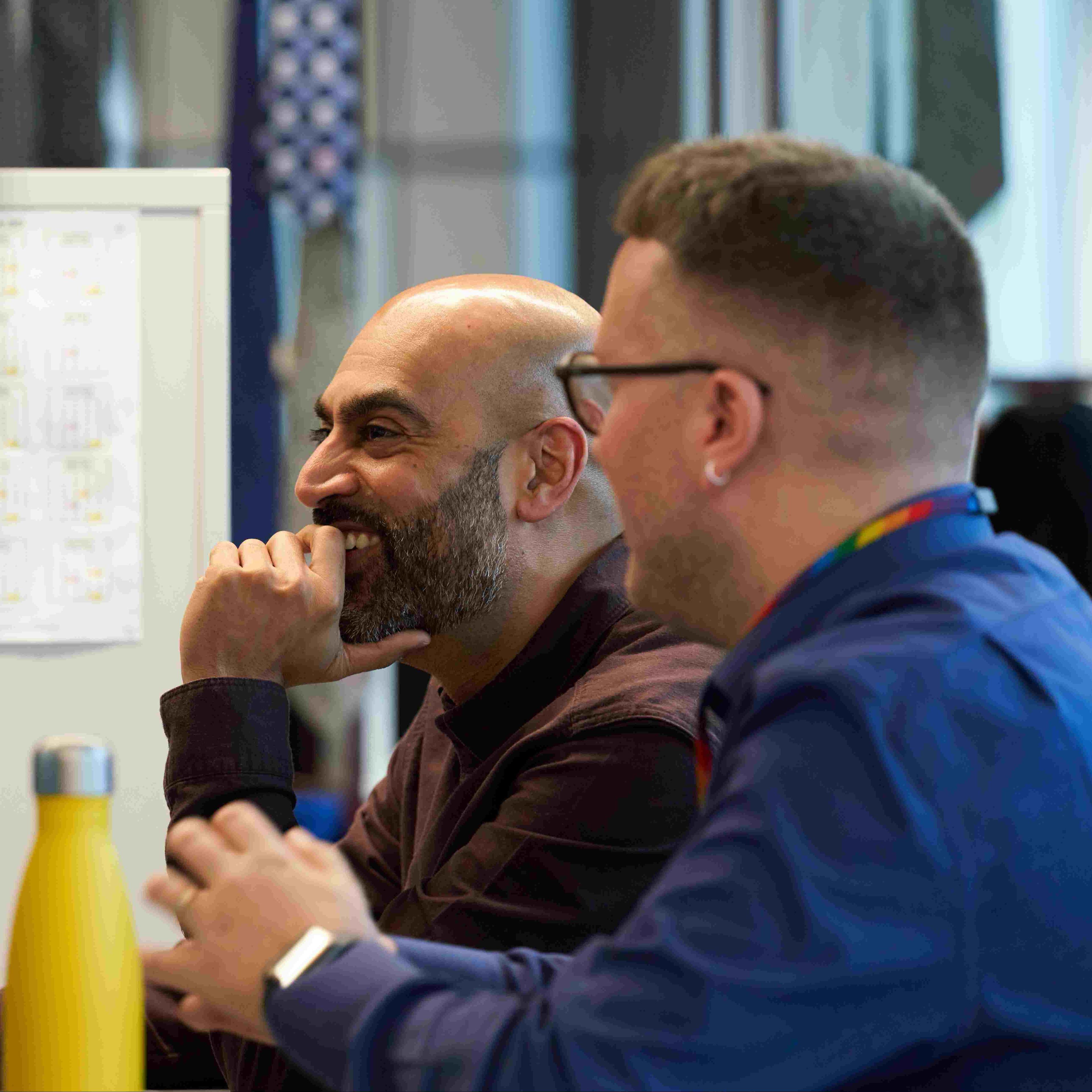Reed has partnered with the CIPD to produce, ‘Inclusion at Work 2022’, a report based on a survey of over 2,000 senior decision-makers from UK organisations.
In today's competitive labour market, showcasing your organisation’s inclusive and diverse culture, and commitment to the cause, has never been more important. With companies battling in the same talent pools, having a diverse and inclusive culture will set you in good stead to attract the best professionals above your competitors.
Dr Jill Miller, Senior Policy Adviser at the CIPD, the brains behind our joint research, talks more about the report, its findings, and what more needs to be done on inclusion and diversity in UK workplaces to ensure the topic stays at the fore.

Q: Why did the CIPD commission the report with Reed on inclusion and diversity?
A: This is a project we’re really excited about because of the potential to affect real change in UK workplaces. We firmly believe that a commitment and focus on creating an inclusive workplace with equality of opportunity for all is the right thing to do and responsible business practice, as well as offering vast benefits to businesses in helping achieve their strategic priorities.
At work, everyone should feel valued and included, so they can be themselves, have the opportunity to reach their potential, and be treated with dignity and respect.
Through the ‘Inclusion at Work 2022’ survey report we want to help employers make strides in creating more inclusive workplaces. We’re delighted to work in partnership with Reed on this project, as together we can help increase the pace of change in creating fair, diverse and inclusive workplaces.
The survey report tells us what UK employers are currently doing to improve inclusion and diversity and the practices they’ve found to be effective. Importantly, it highlights where more action is needed, and we provide seven recommendations for practice to help HR to improve or re-energise their approach. Together we’ll be drawing on the survey findings to encourage many more employers to put in place evidence-based inclusion and diversity strategies and practices.
Q: Why do you think I&D is so important for organisations?
A: There are two main arguments for why having an inclusive, diverse and fair organisation is so important. It’s the right thing to do - everyone should have equality of opportunity in access to work, treatment and outcomes, including feeling able to achieve their potential. A genuine commitment by employers to create fair and inclusive workplaces is essential to tackle the disadvantage experienced by many at work, based on their background, identity, or circumstances.
And there are clear business benefits from taking action. I talk a lot about how a focus on I&D can help employers tackle many of the business challenges they’re facing, for example, in addressing skills shortages and aiding retention. Both are so important with the current recruitment challenges faced by UK businesses of all sectors and sizes, and of course, the need to closely manage costs. More and more people are looking to work for a responsible business and are more likely to want to stay with an organisation if they have a positive experience working there, feel they are treated fairly and with dignity and respect.
In addition, a diversity of perspectives can promote innovation and creativity, and there are consequent benefits for the customer or service user in terms of inclusive service delivery and product development.
Q: What were the top three alarming statistics from the report and how can organisations address these?
A: The three I’ve picked out here are all related to organisations’ overall approach to I&D as that’s an important starting point to ensure I&D is embedded.
Firstly, it was disappointing to find that almost half (47%) of employers don’t have an inclusion and diversity strategy in place. A strategy, which focuses on both diversity and inclusion, can set direction and foster long-term commitment to change across the organisation.
Inclusion, diversity and fairness need to be fundamental principles on which every aspect of an organisation operates, including the people management approach, policies and processes, leadership role modelling, and behavioural norms, and should be part of operational decision-making. Having a strategy in place makes it more likely that I&D will become embedded in an organisation, as opposed to an add-on when time and resources allow.
The second statistic I’d pull out is that a quarter of employers said their I&D approach is entirely or mostly reactive, for example in response to mandatory reporting requirements or societal events. An ad hoc approach is not going to lead to meaningful and lasting change in UK workplaces. Instead, a genuine, proactive approach to diversity, inclusion and fairness is required, informed by an evidence-based understanding of the issues in that organisation.
The third data point that struck me is that just 38% of employers collect some kind of equal opportunities monitoring data from employees and/or job applicants. Following on from this, only a minority of organisations use this data to see who is applying for jobs, being recruited and progressing or to identify where action is needed and plan activity. These findings raise the question of how organisations decide where they focus their I&D efforts and invest resources. And, how do they gain buy-in and make the case for organisation investment (including challenging inaccurate perceptions of I&D and its importance)?
Professionals need to think carefully about how they can get a clear understanding of what’s happening in their organisation and the experience of different employee groups. What additional capabilities may be required of the people function to collect, analyse and draw insight from workforce data?
Q: What advice would you give to organisations who don’t take I&D seriously or have a strategy in place?
A: In terms of recruitment and retention, there’s a real risk you may lose out on hiring and retaining talented people to competitors who are taking I&D seriously. As more and more people look to work for responsible businesses, I&D is an important part of your employer brand. A genuine commitment can help widen the talent pools you recruit from.
Furthermore, corporate responsibility, including I&D, is something organisations are increasingly thinking about when choosing who to do business with.
Without a strategy in place, there is a danger of I&D slipping off the radar or being seen as a ‘nice to have’ rather than integral to how the business wants to operate.
Q: How can we empower managers to put I&D at the fore?
A: In the survey, we found that the design of managers’ job roles is holding them back when it comes to creating an inclusive workplace. Just over a quarter (28%) of employers said managers are not given the time and resources needed to demonstrate a tangible commitment to I&D, and only 29% of managers have I&D as part of their performance objectives. Furthermore, just under half (47%) say that inclusion and diversity considerations take a back seat to operational imperatives, for example when managers are urgently hiring.
Managers are a key influence in the employee experience. They enact the people management practices, design jobs, allocate work and have significant influence over hiring and promotion decisions. Their behaviour and management style shape the climate of the team. Recognising their pivotal role, and allowing the time and space for them within their job role to create an inclusive and diverse workplace, is fundamental to progress in this area.
As with any part of a job role, learning and development is needed to understand what is required of you and to master the skills needed to do the job well. Although some employers are taking steps to equip their managers with the skills they need to manage inclusively, there is a lot of room for improvement. In terms of manager capabilities relating to I&D, only around half of employers (51%) said managers are confident to improve I&D in their team. However, just 23% of employers say they train managers in fair and inclusive people management. What’s particularly interesting is that 87% of employers who do this practice, and were asked about it, say it’s effective in creating a more inclusive and diverse workplace. In fact, all the manager-related practices aiming to improve I&D had low uptake but were rated highly in terms of effectiveness.
Q: What are the biggest barriers when it comes to ensuring I&D is embedded into a company’s culture and how can these be overcome?
A: I’ve talked about quite a few of the common barriers I think employers need to tackle to make I&D ‘part and parcel’ of how they operate, but there are three further points that regularly come up in discussions on I&D that I think employers need to be aware of:
Ensuring a focus on both diversity (the workforce being representative of the community the organisation operates in) and inclusion (valuing difference, people feeling they belong without changing who they are at work, and everyone having equality of opportunity of access to work, progression, and treatment at work). A diverse workforce won’t be able to reach their potential if they don’t feel valued, included and treated fairly, with dignity and respect, and will likely leave.
It's important everyone in the organisation understands what diversity and inclusion mean, the relationship between them, and what an organisation would look like if it had one without the other. The organisation’s strategy and I&D practice needs to address both.
I&D not being taken seriously at a strategic level
Having a strategy in place will help to ensure I&D is on leaders’ agendas and is part of the conversation on all business decisions. It will also help to set expectations about leader behaviour, and can drive progress based on the adage ‘what gets measured gets managed’. Leaders need to understand the value of I&D to a business, the current culture and employee experience, and the importance of their role in creating a genuinely inclusive business.
Making certain the organisation ‘walks the talk’
As I mentioned earlier, a company’s promises on being a responsible business can be a big factor in people applying for a job there. But if people feel the day-to-day reality of working in the organisation doesn’t reflect its espoused values and external employer brand, they’ll leave. It’s essential to get the employee view of how inclusive, or not, the organisation is to help inform where action is needed. Employee surveys, employee resource groups and exit interviews are just three examples of where insight can be gleaned.
Q: Who should own I&D in an organisation?
A: The people function has a central role to play in creating an inclusive, diverse and fair workplace. However, addressing inequalities at work isn’t something that can be done just by the people team alone. They can make a significant impact in a custodian role, but the whole business needs to take responsibility for owning and engaging with a commitment to equality, diversity and inclusion. Whole-business ownership for change and improvement is essential for equality, diversity and inclusion to be a fundamental principle of how the business operates.
Q: With a recession and the current high cost of living, how can companies stay on top of I&D? To what extent should they?
A: It’s essential that organisations retain a strong focus on inclusion and diversity through the more challenging times. Real change requires a systemic approach, so it needs to be a permanent strategic leadership priority.
It’s important to say again that a focus on I&D can actually help employers tackle many of the business challenges they’re facing – managing costs, widening the talent pool to recruit from, aiding retention and enabling people to realise their potential at work, utilising their strengths and capabilities. A diversity of perspectives can help a business find innovative and creative solutions to problems. There can also be benefits in terms of inclusive customer service and product development.
A commitment to having an inclusive workplace is not just for times when businesses are flush with cash (or for those with big budgets). Some of the practices that employers told us they use to improve I&D, and that they rated highly in terms of their effectiveness, would be simple to implement and low-cost. For example, using structured or standardised interview questions, ensuring all involved in recruiting follow objective assessment and scoring criteria, explaining expectations about inclusive behaviour when onboarding employees and reviewing job descriptions to accurately reflect the requirements of the job.
My advice to employers would be to focus on ensuring everyone in the business understands their role in creating an inclusive workplace. However, particular attention needs to focus on leader and manager behaviour as they set the tone of the organisation and people will look to them as role models of ‘how we should act around here’. Training and support to understand what I&D means in their role and how to lead in an inclusive way is important, and both leaders and managers need to be held accountable for doing so, such as through performance objectives.
For more information on how you can inspire a greater pace of change when it comes to inclusion and diversity in your workplace, download the free ‘Inclusion at Work 2022’ report here.





